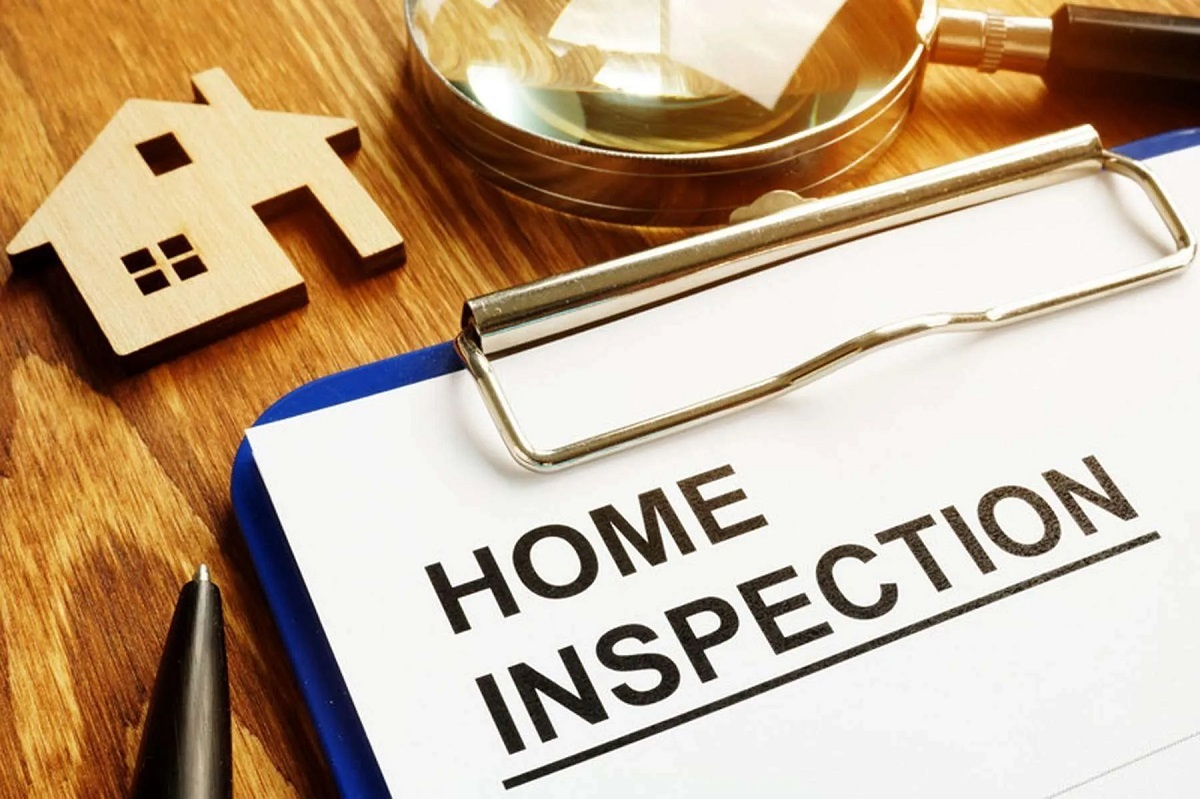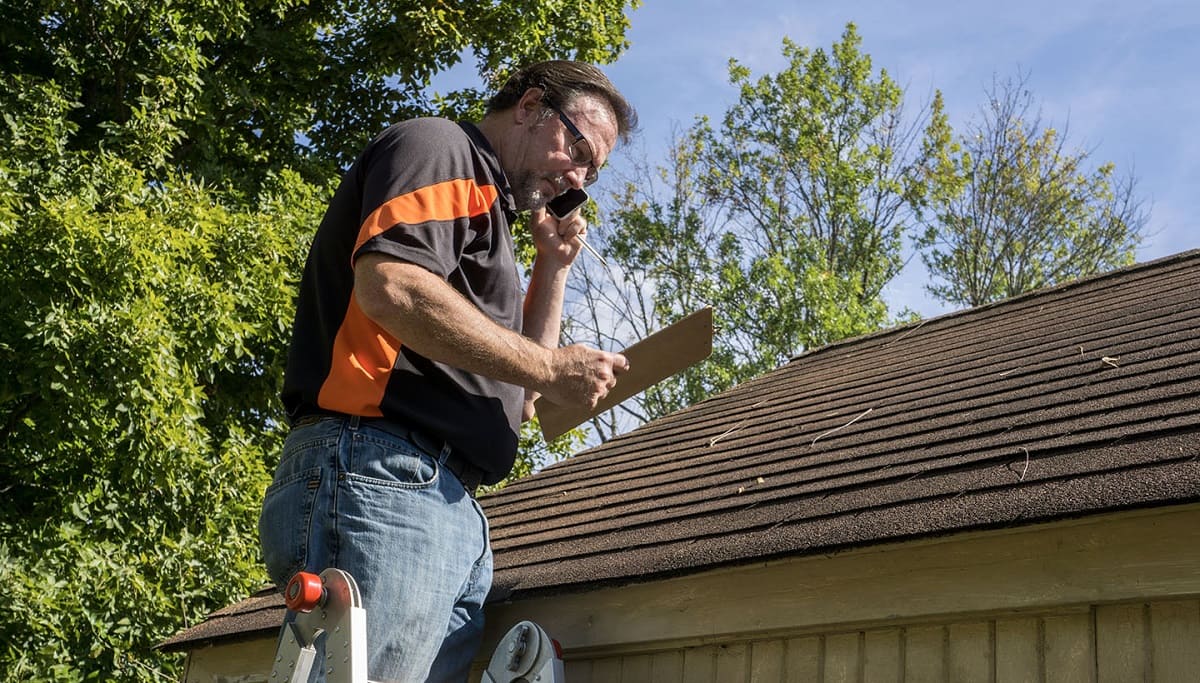Home>Home Maintenance>Should Homeowners Be Present During The Buyer’s Inspection?


Home Maintenance
Should Homeowners Be Present During The Buyer’s Inspection?
Modified: March 6, 2024
Find out if homeowners should be present during the buyer's inspection. Learn the importance of home maintenance in this informative guide.
(Many of the links in this article redirect to a specific reviewed product. Your purchase of these products through affiliate links helps to generate commission for Storables.com, at no extra cost. Learn more)
Introduction
When it comes to selling a home, one crucial step in the process is the buyer’s inspection. This is where a professional home inspector thoroughly examines the property to assess its condition and identify any issues or potential problems. The question many homeowners face is whether they should be present during this inspection.
The decision to be present during the buyer’s inspection is a personal one, and it ultimately depends on the homeowner’s comfort level and preference. Some homeowners prefer to be there to address any concerns or provide additional information, while others feel that it is best to allow the inspector to do their job without interference. In this article, we will discuss both the pros and cons of homeowners being present during the buyer’s inspection.
Key Takeaways:
- Should Homeowners Be Present During the Buyer’s Inspection?
Homeowners being present during the buyer’s inspection can help with communication and immediate addressing of concerns, but it may also interfere with the inspector’s work and lead to emotional involvement.
- Should Homeowners Be Present During the Buyer’s Inspection?
While homeowners being present can aid in sharing property information and building trust, it may also pressure the home inspector and limit objectivity due to emotional attachment.
Pros of Homeowners Being Present During the Buyer’s Inspection
While it is not necessary for homeowners to be present during the buyer’s inspection, there are several advantages to consider if they choose to be. Here are some of the key benefits:
- Opportunity for Communication and Clarification: Being present during the inspection allows homeowners to directly communicate with the inspector. They can ask questions, seek clarification on any issues, and gain a better understanding of the property’s condition. This can be particularly helpful if there are unique features or systems in the home that require explanation.
- Immediate Addressing of Concerns and Repairs: If the homeowner is present during the inspection, they can quickly address any concerns that arise. For instance, if the inspector discovers a minor issue, the homeowner can provide immediate clarification or take steps to rectify the problem on the spot. This proactive approach can help streamline the negotiation process and potentially prevent small issues from becoming major obstacles to closing the sale.
- Sharing of Important Property Information: Homeowners often possess valuable knowledge about their property that the inspector may not be aware of. This can include details about recent repairs, maintenance history, or warranties that are still valid. Being present allows homeowners to share this information, ensuring that the inspector has a comprehensive understanding of the property’s condition and minimizes any potential misunderstandings or communication gaps.
- Building Trust and Rapport: By being present during the inspection, homeowners have the opportunity to establish a personal connection with potential buyers. This can help build trust and rapport, which is crucial when negotiating repairs or addressing other concerns. Buyers may feel more confident knowing that the homeowner is actively involved and genuinely interested in the property’s condition.
Key Takeaways:
- Should Homeowners Be Present During the Buyer’s Inspection?
Homeowners being present during the buyer’s inspection can help with communication and immediate addressing of concerns, but it may also interfere with the inspector’s work and lead to emotional involvement.
- Should Homeowners Be Present During the Buyer’s Inspection?
While homeowners being present can aid in sharing property information and building trust, it may also pressure the home inspector and limit objectivity due to emotional attachment.
Pros of Homeowners Being Present During the Buyer’s Inspection
-
Opportunity for Communication and Clarification
One of the significant advantages of homeowners being present during the buyer’s inspection is the opportunity for direct communication and clarification. While the home inspector is trained to identify issues and assess the property’s condition, there may be aspects of the home that require explanation or further context.
By being present, homeowners can engage in a dialogue with the inspector and ask questions about any concerns or areas of interest. This allows for a better understanding of the property’s condition and can help homeowners make informed decisions about repairs, negotiations, or disclosures.
For example, if the inspector identifies a crack in the foundation, the homeowner can inquire about the severity of the issue, potential causes, and recommended solutions. This direct interaction enables homeowners to gather essential information and gain peace of mind regarding the property’s condition.
In addition to clarifying specific concerns, being present during the inspection provides a platform for homeowners to ask general questions about the property’s maintenance, systems, or any potential future upgrades. The inspector can provide valuable insights and guidance, helping homeowners understand how to properly care for and maintain their home.
Overall, the opportunity for communication and clarification during the buyer’s inspection empowers homeowners with knowledge and enables them to have a more comprehensive understanding of their property’s condition.
Key Takeaways:
- Should Homeowners Be Present During the Buyer’s Inspection?
Homeowners being present during the buyer’s inspection can help with communication and immediate addressing of concerns, but it may also interfere with the inspector’s work and lead to emotional involvement.
- Should Homeowners Be Present During the Buyer’s Inspection?
While homeowners being present can aid in sharing property information and building trust, it may also pressure the home inspector and limit objectivity due to emotional attachment.
Pros of Homeowners Being Present During the Buyer’s Inspection
-
Opportunity for Communication and Clarification
One of the significant advantages of homeowners being present during the buyer’s inspection is the opportunity for direct communication and clarification. While the home inspector is trained to identify issues and assess the property’s condition, there may be aspects of the home that require explanation or further context.
By being present, homeowners can engage in a dialogue with the inspector and ask questions about any concerns or areas of interest. This allows for a better understanding of the property’s condition and can help homeowners make informed decisions about repairs, negotiations, or disclosures.
For example, if the inspector identifies a crack in the foundation, the homeowner can inquire about the severity of the issue, potential causes, and recommended solutions. This direct interaction enables homeowners to gather essential information and gain peace of mind regarding the property’s condition.
In addition to clarifying specific concerns, being present during the inspection provides a platform for homeowners to ask general questions about the property’s maintenance, systems, or any potential future upgrades. The inspector can provide valuable insights and guidance, helping homeowners understand how to properly care for and maintain their home.
Overall, the opportunity for communication and clarification during the buyer’s inspection empowers homeowners with knowledge and enables them to have a more comprehensive understanding of their property’s condition.
-
Immediate Addressing of Concerns and Repairs
Another advantage of homeowners being present during the buyer’s inspection is the ability to address concerns and repairs immediately. When potential issues are identified, having the homeowner on-site allows for prompt communication and immediate action.
For instance, if the inspector discovers a leaky faucet or a faulty electrical outlet, the homeowner can quickly offer an explanation or rectify the problem on the spot. This proactive approach not only demonstrates the homeowner’s commitment to maintaining the property but can also expedite the negotiation process.
By addressing repairs promptly, homeowners can avoid unnecessary delays and potential disputes during the transaction. It shows potential buyers that the homeowner is attentive and willing to invest in the property’s upkeep.
In some cases, being present during the inspection can also lead to cost-effective solutions. For minor issues that can be resolved without professional intervention, homeowners can save money by taking care of the repairs themselves.
Overall, the ability to address concerns and repairs immediately not only streamlines the transaction process but also enhances the overall perception of the property’s condition and the homeowner’s attentiveness to maintenance.
Key Takeaways:
- Should Homeowners Be Present During the Buyer’s Inspection?
Homeowners being present during the buyer’s inspection can help with communication and immediate addressing of concerns, but it may also interfere with the inspector’s work and lead to emotional involvement.
- Should Homeowners Be Present During the Buyer’s Inspection?
While homeowners being present can aid in sharing property information and building trust, it may also pressure the home inspector and limit objectivity due to emotional attachment.
Pros of Homeowners Being Present During the Buyer’s Inspection
-
Opportunity for Communication and Clarification
One of the significant advantages of homeowners being present during the buyer’s inspection is the opportunity for direct communication and clarification. While the home inspector is trained to identify issues and assess the property’s condition, there may be aspects of the home that require explanation or further context.
By being present, homeowners can engage in a dialogue with the inspector and ask questions about any concerns or areas of interest. This allows for a better understanding of the property’s condition and can help homeowners make informed decisions about repairs, negotiations, or disclosures.
For example, if the inspector identifies a crack in the foundation, the homeowner can inquire about the severity of the issue, potential causes, and recommended solutions. This direct interaction enables homeowners to gather essential information and gain peace of mind regarding the property’s condition.
In addition to clarifying specific concerns, being present during the inspection provides a platform for homeowners to ask general questions about the property’s maintenance, systems, or any potential future upgrades. The inspector can provide valuable insights and guidance, helping homeowners understand how to properly care for and maintain their home.
Overall, the opportunity for communication and clarification during the buyer’s inspection empowers homeowners with knowledge and enables them to have a more comprehensive understanding of their property’s condition.
-
Immediate Addressing of Concerns and Repairs
Another advantage of homeowners being present during the buyer’s inspection is the ability to address concerns and repairs immediately. When potential issues are identified, having the homeowner on-site allows for prompt communication and immediate action.
For instance, if the inspector discovers a leaky faucet or a faulty electrical outlet, the homeowner can quickly offer an explanation or rectify the problem on the spot. This proactive approach not only demonstrates the homeowner’s commitment to maintaining the property but can also expedite the negotiation process.
By addressing repairs promptly, homeowners can avoid unnecessary delays and potential disputes during the transaction. It shows potential buyers that the homeowner is attentive and willing to invest in the property’s upkeep.
In some cases, being present during the inspection can also lead to cost-effective solutions. For minor issues that can be resolved without professional intervention, homeowners can save money by taking care of the repairs themselves.
Overall, the ability to address concerns and repairs immediately not only streamlines the transaction process but also enhances the overall perception of the property’s condition and the homeowner’s attentiveness to maintenance.
-
Sharing of Important Property Information
Homeowners possess crucial knowledge about their property that can contribute to the inspection process. By being present during the buyer’s inspection, homeowners have the opportunity to share important property information with the inspector.
For example, homeowners can provide details about recent repairs, renovations, or maintenance activities that may not be immediately visible. Sharing this information can help the inspector understand the context of certain aspects of the property, such as a newly replaced roof or an updated HVAC system.
Additionally, homeowners may have documentation, warranties, or service contracts pertaining to various components of the home. Making these documents available to the inspector can aid in their evaluation and provide a comprehensive understanding of the property’s condition.
By sharing important property information, homeowners contribute to a more accurate and thorough inspection. This ensures that the inspector has access to all relevant details, enabling them to provide a comprehensive report to the potential buyers.
Furthermore, the sharing of property information fosters transparency and trust between the parties involved. It demonstrates the homeowner’s willingness to provide complete and truthful information, which can positively impact the buyer’s perception of the property.
Overall, the sharing of important property information during the inspection allows for a more comprehensive evaluation and contributes to a smoother and more transparent transaction.
Key Takeaways:
- Should Homeowners Be Present During the Buyer’s Inspection?
Homeowners being present during the buyer’s inspection can help with communication and immediate addressing of concerns, but it may also interfere with the inspector’s work and lead to emotional involvement.
- Should Homeowners Be Present During the Buyer’s Inspection?
While homeowners being present can aid in sharing property information and building trust, it may also pressure the home inspector and limit objectivity due to emotional attachment.
Pros of Homeowners Being Present During the Buyer’s Inspection
-
Opportunity for Communication and Clarification
One of the significant advantages of homeowners being present during the buyer’s inspection is the opportunity for direct communication and clarification. While the home inspector is trained to identify issues and assess the property’s condition, there may be aspects of the home that require explanation or further context.
By being present, homeowners can engage in a dialogue with the inspector and ask questions about any concerns or areas of interest. This allows for a better understanding of the property’s condition and can help homeowners make informed decisions about repairs, negotiations, or disclosures.
For example, if the inspector identifies a crack in the foundation, the homeowner can inquire about the severity of the issue, potential causes, and recommended solutions. This direct interaction enables homeowners to gather essential information and gain peace of mind regarding the property’s condition.
In addition to clarifying specific concerns, being present during the inspection provides a platform for homeowners to ask general questions about the property’s maintenance, systems, or any potential future upgrades. The inspector can provide valuable insights and guidance, helping homeowners understand how to properly care for and maintain their home.
Overall, the opportunity for communication and clarification during the buyer’s inspection empowers homeowners with knowledge and enables them to have a more comprehensive understanding of their property’s condition.
-
Immediate Addressing of Concerns and Repairs
Another advantage of homeowners being present during the buyer’s inspection is the ability to address concerns and repairs immediately. When potential issues are identified, having the homeowner on-site allows for prompt communication and immediate action.
For instance, if the inspector discovers a leaky faucet or a faulty electrical outlet, the homeowner can quickly offer an explanation or rectify the problem on the spot. This proactive approach not only demonstrates the homeowner’s commitment to maintaining the property but can also expedite the negotiation process.
By addressing repairs promptly, homeowners can avoid unnecessary delays and potential disputes during the transaction. It shows potential buyers that the homeowner is attentive and willing to invest in the property’s upkeep.
In some cases, being present during the inspection can also lead to cost-effective solutions. For minor issues that can be resolved without professional intervention, homeowners can save money by taking care of the repairs themselves.
Overall, the ability to address concerns and repairs immediately not only streamlines the transaction process but also enhances the overall perception of the property’s condition and the homeowner’s attentiveness to maintenance.
-
Sharing of Important Property Information
Homeowners possess crucial knowledge about their property that can contribute to the inspection process. By being present during the buyer’s inspection, homeowners have the opportunity to share important property information with the inspector.
For example, homeowners can provide details about recent repairs, renovations, or maintenance activities that may not be immediately visible. Sharing this information can help the inspector understand the context of certain aspects of the property, such as a newly replaced roof or an updated HVAC system.
Additionally, homeowners may have documentation, warranties, or service contracts pertaining to various components of the home. Making these documents available to the inspector can aid in their evaluation and provide a comprehensive understanding of the property’s condition.
By sharing important property information, homeowners contribute to a more accurate and thorough inspection. This ensures that the inspector has access to all relevant details, enabling them to provide a comprehensive report to the potential buyers.
Furthermore, the sharing of property information fosters transparency and trust between the parties involved. It demonstrates the homeowner’s willingness to provide complete and truthful information, which can positively impact the buyer’s perception of the property.
Overall, the sharing of important property information during the inspection allows for a more comprehensive evaluation and contributes to a smoother and more transparent transaction.
-
Building Trust and Rapport
Being present during the buyer’s inspection provides an opportunity for homeowners to build trust and rapport with potential buyers. This interpersonal connection can have a significant impact on the outcome of the inspection and the overall transaction process.
By being available to answer questions and address concerns directly, homeowners can demonstrate their commitment to transparency and honesty. This can create a sense of trust between the parties involved, as potential buyers can see that the homeowners are actively engaged and interested in the property’s condition.
Furthermore, being present during the inspection allows homeowners to showcase their knowledge and familiarity with the property. They can provide insights into the home’s unique features, historical context, or neighborhood advantages. This personal touch can help potential buyers envision themselves living in the home and foster a positive connection.
In addition, being present allows homeowners to understand the concerns and priorities of potential buyers. By actively listening to their questions and feedback, homeowners can gain valuable insights into the buyer’s perspective and adjust their selling strategy accordingly.
Overall, building trust and rapport through being present during the buyer’s inspection can contribute to a smoother and more successful transaction. It creates a foundation of mutual understanding and collaboration, which bodes well for negotiations and the overall buying experience.
Cons of Homeowners Being Present During the Buyer’s Inspection
While there are benefits to homeowners being present during the buyer’s inspection, there are also some potential drawbacks to consider. Here are some of the cons:
- Interference with the Inspection Process: Homeowners being present during the inspection can unintentionally disrupt the flow of the inspection. By asking too many questions or being overly involved, homeowners may inadvertently hinder the inspector’s ability to focus on their task. This can result in an incomplete or less thorough inspection, potentially leading to overlooked issues.
- Potential for Emotional Involvement: Selling a home can be an emotional process for homeowners, and being present during the inspection may amplify these emotions. If the inspector identifies issues or suggests repairs, homeowners might react emotionally, which can negatively impact the negotiation process. Emotional involvement can cloud judgment and hinder objective decision-making.
- Pressure on the Home Inspector: The presence of homeowners during the inspection may unintentionally put pressure on the home inspector to provide favorable results or downplay issues. Inspectors should remain impartial and provide an unbiased assessment of the property’s condition. The pressure to please homeowners may compromise the inspector’s objectivity and integrity.
- Limited Objectivity: Homeowners may have a personal attachment to their property, making it challenging to objectively view potential flaws or weaknesses. Their presence during the inspection might influence their perception of the inspector’s findings and their willingness to address necessary repairs. This limited objectivity can hinder the negotiation process and create challenges in reaching an agreement.
It is important for homeowners to weigh these cons against the benefits of being present during the buyer’s inspection and make an informed decision based on their individual circumstances and comfort level. By considering both the pros and cons, homeowners can determine whether their presence will be beneficial or potentially detrimental to the inspection process and the overall sale of their home.
Cons of Homeowners Being Present During the Buyer’s Inspection
-
Interference with the Inspection Process
One of the potential drawbacks of homeowners being present during the buyer’s inspection is the possibility of interference with the inspection process. While homeowners may have good intentions, their presence can unintentionally disrupt the workflow and distract the home inspector from conducting a thorough examination of the property.
When homeowners are present, there is a tendency to ask numerous questions or provide excessive commentary. While it is understandable that homeowners may want to gain insights into the condition of their property, excessive involvement can hinder the inspector’s focus and ability to perform their job effectively.
The purpose of the buyer’s inspection is to provide an unbiased assessment of the property’s condition. The home inspector needs to concentrate on their observations, documentation, and evaluation without external distractions. Homeowners being present can lead to interruptions in the inspector’s thought process, potentially resulting in overlooked issues or incomplete assessments.
Furthermore, the presence of homeowners may inadvertently disrupt the inspector’s routine and rhythm, making it challenging for them to adhere to their established inspection procedures. This can result in a less efficient inspection and may compromise the accuracy and comprehensiveness of the final inspection report.
In order to ensure a thorough and uninterrupted inspection process, it is generally recommended that homeowners allow the inspector to work independently. This allows the inspector to focus on their task and provide an objective assessment of the property’s condition without any external influence.
By allowing the inspector to carry out their duties without interference, homeowners can have confidence in the accuracy and integrity of the inspection report, providing potential buyers with an unbiased representation of the property.
Cons of Homeowners Being Present During the Buyer’s Inspection
-
Interference with the Inspection Process
One of the potential drawbacks of homeowners being present during the buyer’s inspection is the possibility of interference with the inspection process. While homeowners may have good intentions, their presence can unintentionally disrupt the workflow and distract the home inspector from conducting a thorough examination of the property.
When homeowners are present, there is a tendency to ask numerous questions or provide excessive commentary. While it is understandable that homeowners may want to gain insights into the condition of their property, excessive involvement can hinder the inspector’s focus and ability to perform their job effectively.
The purpose of the buyer’s inspection is to provide an unbiased assessment of the property’s condition. The home inspector needs to concentrate on their observations, documentation, and evaluation without external distractions. Homeowners being present can lead to interruptions in the inspector’s thought process, potentially resulting in overlooked issues or incomplete assessments.
Furthermore, the presence of homeowners may inadvertently disrupt the inspector’s routine and rhythm, making it challenging for them to adhere to their established inspection procedures. This can result in a less efficient inspection and may compromise the accuracy and comprehensiveness of the final inspection report.
In order to ensure a thorough and uninterrupted inspection process, it is generally recommended that homeowners allow the inspector to work independently. This allows the inspector to focus on their task and provide an objective assessment of the property’s condition without any external influence.
By allowing the inspector to carry out their duties without interference, homeowners can have confidence in the accuracy and integrity of the inspection report, providing potential buyers with an unbiased representation of the property.
-
Potential for Emotional Involvement
Another potential downside of homeowners being present during the buyer’s inspection is the risk of emotional involvement. Selling a home can be an emotional process, and homeowners may have a deep attachment to their property. Being present during the inspection can amplify these emotions and cloud judgment.
When issues or potential problems are identified during the inspection, homeowners may react emotionally, especially if they were previously unaware of the issues. This emotional response can hinder the negotiation process and make it more challenging to reach an agreement on repairs or pricing.
Emotional involvement may also lead to a biased perspective on the inspector’s findings. Homeowners may become defensive or dismissive of issues that are identified, delaying necessary repairs or negotiations. This can create tension and mistrust between the parties involved, potentially derailing the sale process.
Moreover, the emotional attachment to the property can result in unrealistic expectations from homeowners. They may have an idealized view of their home and be unwilling to acknowledge or address certain shortcomings that are identified during the inspection. This can lead to friction with potential buyers and impede the negotiation process.
In order to maintain objectivity and a smooth transaction process, it may be best for homeowners to allow the inspector and potential buyers to assess the property without emotional interference. By stepping back and allowing the professionals to do their job, homeowners can avoid unnecessary conflicts and focus on reaching a mutually beneficial agreement.
Cons of Homeowners Being Present During the Buyer’s Inspection
-
Interference with the Inspection Process
One of the potential drawbacks of homeowners being present during the buyer’s inspection is the possibility of interference with the inspection process. While homeowners may have good intentions, their presence can unintentionally disrupt the workflow and distract the home inspector from conducting a thorough examination of the property.
When homeowners are present, there is a tendency to ask numerous questions or provide excessive commentary. While it is understandable that homeowners may want to gain insights into the condition of their property, excessive involvement can hinder the inspector’s focus and ability to perform their job effectively.
The purpose of the buyer’s inspection is to provide an unbiased assessment of the property’s condition. The home inspector needs to concentrate on their observations, documentation, and evaluation without external distractions. Homeowners being present can lead to interruptions in the inspector’s thought process, potentially resulting in overlooked issues or incomplete assessments.
Furthermore, the presence of homeowners may inadvertently disrupt the inspector’s routine and rhythm, making it challenging for them to adhere to their established inspection procedures. This can result in a less efficient inspection and may compromise the accuracy and comprehensiveness of the final inspection report.
In order to ensure a thorough and uninterrupted inspection process, it is generally recommended that homeowners allow the inspector to work independently. This allows the inspector to focus on their task and provide an objective assessment of the property’s condition without any external influence.
By allowing the inspector to carry out their duties without interference, homeowners can have confidence in the accuracy and integrity of the inspection report, providing potential buyers with an unbiased representation of the property.
-
Potential for Emotional Involvement
Another potential downside of homeowners being present during the buyer’s inspection is the risk of emotional involvement. Selling a home can be an emotional process, and homeowners may have a deep attachment to their property. Being present during the inspection can amplify these emotions and cloud judgment.
When issues or potential problems are identified during the inspection, homeowners may react emotionally, especially if they were previously unaware of the issues. This emotional response can hinder the negotiation process and make it more challenging to reach an agreement on repairs or pricing.
Emotional involvement may also lead to a biased perspective on the inspector’s findings. Homeowners may become defensive or dismissive of issues that are identified, delaying necessary repairs or negotiations. This can create tension and mistrust between the parties involved, potentially derailing the sale process.
Moreover, the emotional attachment to the property can result in unrealistic expectations from homeowners. They may have an idealized view of their home and be unwilling to acknowledge or address certain shortcomings that are identified during the inspection. This can lead to friction with potential buyers and impede the negotiation process.
In order to maintain objectivity and a smooth transaction process, it may be best for homeowners to allow the inspector and potential buyers to assess the property without emotional interference. By stepping back and allowing the professionals to do their job, homeowners can avoid unnecessary conflicts and focus on reaching a mutually beneficial agreement.
-
Pressure on the Home Inspector
Homeowners being present during the buyer’s inspection can inadvertently put pressure on the home inspector to provide favorable results or downplay issues. While most home inspectors are trained to remain objective and provide an unbiased assessment, the presence of homeowners can create an atmosphere where the inspector feels compelled to please the homeowner.
When homeowners are present, there is a natural tendency for them to have expectations about the inspection process and its outcomes. Home inspectors may feel pressured to report fewer issues or downplay their severity to avoid disappointing or upsetting the homeowners.
This pressure on the home inspector compromises their objectivity and integrity, as it may lead them to overlook or gloss over potential problems. It is important for home inspectors to maintain their professionalism and adhere to their ethical obligations to provide accurate and unbiased reporting.
Furthermore, the presence of homeowners during the inspection may create an uncomfortable dynamic for the home inspector. They may feel scrutinized or evaluated by the homeowners, which can impact their ability to focus on their work and perform a thorough inspection.
In order to alleviate pressure on the home inspector and ensure an unbiased assessment, homeowners should consider allowing the inspector to work independently. This allows the inspector to remain focused, objective, and provide an honest evaluation of the property’s condition without any external influence.
Cons of Homeowners Being Present During the Buyer’s Inspection
-
Interference with the Inspection Process
One of the potential drawbacks of homeowners being present during the buyer’s inspection is the possibility of interference with the inspection process. While homeowners may have good intentions, their presence can unintentionally disrupt the workflow and distract the home inspector from conducting a thorough examination of the property.
When homeowners are present, there is a tendency to ask numerous questions or provide excessive commentary. While it is understandable that homeowners may want to gain insights into the condition of their property, excessive involvement can hinder the inspector’s focus and ability to perform their job effectively.
The purpose of the buyer’s inspection is to provide an unbiased assessment of the property’s condition. The home inspector needs to concentrate on their observations, documentation, and evaluation without external distractions. Homeowners being present can lead to interruptions in the inspector’s thought process, potentially resulting in overlooked issues or incomplete assessments.
Furthermore, the presence of homeowners may inadvertently disrupt the inspector’s routine and rhythm, making it challenging for them to adhere to their established inspection procedures. This can result in a less efficient inspection and may compromise the accuracy and comprehensiveness of the final inspection report.
In order to ensure a thorough and uninterrupted inspection process, it is generally recommended that homeowners allow the inspector to work independently. This allows the inspector to focus on their task and provide an objective assessment of the property’s condition without any external influence.
By allowing the inspector to carry out their duties without interference, homeowners can have confidence in the accuracy and integrity of the inspection report, providing potential buyers with an unbiased representation of the property.
-
Potential for Emotional Involvement
Another potential downside of homeowners being present during the buyer’s inspection is the risk of emotional involvement. Selling a home can be an emotional process, and homeowners may have a deep attachment to their property. Being present during the inspection can amplify these emotions and cloud judgment.
When issues or potential problems are identified during the inspection, homeowners may react emotionally, especially if they were previously unaware of the issues. This emotional response can hinder the negotiation process and make it more challenging to reach an agreement on repairs or pricing.
Emotional involvement may also lead to a biased perspective on the inspector’s findings. Homeowners may become defensive or dismissive of issues that are identified, delaying necessary repairs or negotiations. This can create tension and mistrust between the parties involved, potentially derailing the sale process.
Moreover, the emotional attachment to the property can result in unrealistic expectations from homeowners. They may have an idealized view of their home and be unwilling to acknowledge or address certain shortcomings that are identified during the inspection. This can lead to friction with potential buyers and impede the negotiation process.
In order to maintain objectivity and a smooth transaction process, it may be best for homeowners to allow the inspector and potential buyers to assess the property without emotional interference. By stepping back and allowing the professionals to do their job, homeowners can avoid unnecessary conflicts and focus on reaching a mutually beneficial agreement.
-
Pressure on the Home Inspector
Homeowners being present during the buyer’s inspection can inadvertently put pressure on the home inspector to provide favorable results or downplay issues. While most home inspectors are trained to remain objective and provide an unbiased assessment, the presence of homeowners can create an atmosphere where the inspector feels compelled to please the homeowner.
When homeowners are present, there is a natural tendency for them to have expectations about the inspection process and its outcomes. Home inspectors may feel pressured to report fewer issues or downplay their severity to avoid disappointing or upsetting the homeowners.
This pressure on the home inspector compromises their objectivity and integrity, as it may lead them to overlook or gloss over potential problems. It is important for home inspectors to maintain their professionalism and adhere to their ethical obligations to provide accurate and unbiased reporting.
Furthermore, the presence of homeowners during the inspection may create an uncomfortable dynamic for the home inspector. They may feel scrutinized or evaluated by the homeowners, which can impact their ability to focus on their work and perform a thorough inspection.
In order to alleviate pressure on the home inspector and ensure an unbiased assessment, homeowners should consider allowing the inspector to work independently. This allows the inspector to remain focused, objective, and provide an honest evaluation of the property’s condition without any external influence.
-
Limited Objectivity
When homeowners are present during the buyer’s inspection, there is a risk of limited objectivity in their assessment of the property’s condition. Homeowners may have a personal attachment to their home, which can affect their ability to objectively evaluate any identified issues or potential problems.
This limited objectivity can lead to a biased perspective on the inspection findings. Homeowners may downplay or dismiss certain issues, considering them as minor or insignificant. This can create a disconnect between the homeowner and potential buyers, making it difficult to reach an agreement on repairs or price adjustments.
Furthermore, limited objectivity can hinder the negotiation process. When homeowners are emotionally invested in their property, they may be less willing to compromise or make necessary repairs, leading to potential delays or deadlocks in the transaction.
By allowing the inspector to assess the property independently and providing potential buyers with an objective evaluation, homeowners can avoid the influence of personal biases and ensure a fair negotiation process.
Conclusion
The decision of whether homeowners should be present during the buyer’s inspection is ultimately a personal one, and there are both pros and cons to consider. Being present during the inspection can provide homeowners with an opportunity for communication and clarification, immediate addressing of concerns and repairs, sharing important property information, and building trust and rapport with potential buyers.
However, there are also potential drawbacks. Homeowners being present can interfere with the inspection process, potentially distracting the home inspector and compromising the thoroughness of the assessment. Emotional involvement can arise, leading to biased perspectives and unrealistic expectations. The presence of homeowners may also inadvertently pressure the home inspector to provide favorable results, compromising their objectivity. Additionally, limited objectivity may arise due to the homeowner’s personal attachment to the property.
Considering these factors, homeowners should carefully evaluate their level of comfort, the specific circumstances of the property, and the guidance of their real estate agent or professional home inspector. In cases where homeowners choose to be present during the inspection, it is recommended to strike a balance and allow the inspector to work independently while being available for questions or clarifications if needed.
Ultimately, the objective of the buyer’s inspection is to provide potential buyers with a comprehensive and unbiased assessment of the property’s condition. By respecting the professionalism and expertise of the home inspector and maintaining clear lines of communication, homeowners can contribute to a smoother and more successful transaction process.
Frequently Asked Questions about Should Homeowners Be Present During The Buyer's Inspection?
Was this page helpful?
At Storables.com, we guarantee accurate and reliable information. Our content, validated by Expert Board Contributors, is crafted following stringent Editorial Policies. We're committed to providing you with well-researched, expert-backed insights for all your informational needs.









0 thoughts on “Should Homeowners Be Present During The Buyer’s Inspection?”